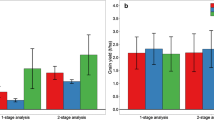Abstract
The national maize improvement program in Nepal regularly receives elite maize (Zea mays L.) genotypes from CIMMYT and other countries and tests them for their performance stability in highly diverse environments. Studies were conducted on research stations and farmers’ fields at five sites in three years to determine performance stability of exotic maize genotypes. Replicated on-station and on-farm studies were conducted using 25 and 10 genotypes, respectively, including a local check and an improved check (Manakamana-3), in 2004–2006. We analyzed grain yield, days to flowering, plant and ear height, plant population, husk cover, and plant and ear aspect. Stability and genotype superiority for grain yield was determined using genotype and genotype × environment (GGE) biplot analysis that compares among a set of genotypes with a reference ‘ideal’ genotype, which has the highest average value of all genotypes and is absolutely stable. Several genotypes produced significantly higher grain yield than the local check. Four genotypes (‘Across9942 × Across9944’, ‘Open Ended White Hill Population’, ‘Population 44C10’ and ‘ZM621’), that produced significantly higher grain yield than the improved check, also had other agronomic traits (days to flowering, plant and ear height, number of ears, resistance to leaf blight, plant and ear aspect and husk cover tightness) equal to or better than the improved check. GGE-biplot analysis showed that Across9942 × Across9944 and ZM621 were the most superior genotypes in the on-station and on-farm trials, respectively. The findings from this study provide new information on the stability of the maize genotypes that are also adapted to other regions of the world. Such information could be useful for maize improvement program for the highlands in Nepal and other similar environments.


Similar content being viewed by others
References
Archer TL, Wiseman BR, Bockholt AJ (1994) Factors affecting corn earworm (Lepidoptera: Noctuidae) resistance in food corn. J Agric Entomol 11:9–16
Butron A, Widstrom NW, Snook ME, Wiseman BR (2002) Recurrent selection for corn earworm (Lepidoptera: Noctuidae) resistance in three closely related corn southern synthetics. J Econ Entomol 95:458–462
CIMMYT (1985) Managing trials and reporting data for CIMMYT’s International Maize Testing Program. Mexico, D.F
CIMMYT (2002) The Hill Maize Research Project, Annual Report 2002. http://www.cimmyt.org/hmrpii/docs/HMRP%202002%20Annual%20Report.doc. Verified 1 November 2007
Farrar JJ, Davis RM (1991) Relationships among ear morphology, western flower thrips, and Fusarium ear rot of corn. Phytopathology 81:661–666
Gabriel KR (1971) The biplot graphic display of matrices with application to principal component analysis. Biometrika 58:453–467
Gomez KA, Gomez AA (1984) Statistical procedures for agricultural research. 2nd ed. John Wiley & Sons, New York, p 304
HMRP (2006) The Hill Maize Research Project Phase II. Annual Report. CIMMYT, South Asia Regional Office, Kathmandu, Nepal
Ransom JK, Paudyal K, Adhikari K (2003) Adoption of improved maize varieties in the hills of Nepal. Agric Econ 29:299–305
SAS Institute (2003) SAS 9.1 for Windows. SAS Institute Inc., Cary, NC, USA
Tiwari TP, Brook RM, Sinclair FM (2004) Implications of hill farmers’ agronomic practices in Nepal for crop improvement in maize. Expl Agric 40:397–417
Yan W, Kang MS (2002) GGE Biplot analysis: a graphical tool for breeders, geneticists, and agronomists. CRC Press, New York, USA
Yan W, Hunt LA, Sheng Q, Szlavnics Z (2000) Cultivar evaluation and mega-environment investigation based on the GGE biplot. Crop Sci 40:597–605
Acknowledgements
The authors appreciate the assistance of Mr. Surath Pradhan in preparing the tables and figures. This study was conducted as a part of the Hill Maize Research Project under financial support by Swiss Agency for Development and Cooperation (SDC) to the Government of Nepal and CIMMYT (Grant no. M0142).
Author information
Authors and Affiliations
Corresponding author
Rights and permissions
About this article
Cite this article
Sharma, D., Sharma, R.C., Dhakal, R. et al. Performance stability of maize genotypes across diverse hill environments in Nepal . Euphytica 164, 689–698 (2008). https://doi.org/10.1007/s10681-008-9682-9
Received:
Accepted:
Published:
Issue Date:
DOI: https://doi.org/10.1007/s10681-008-9682-9




